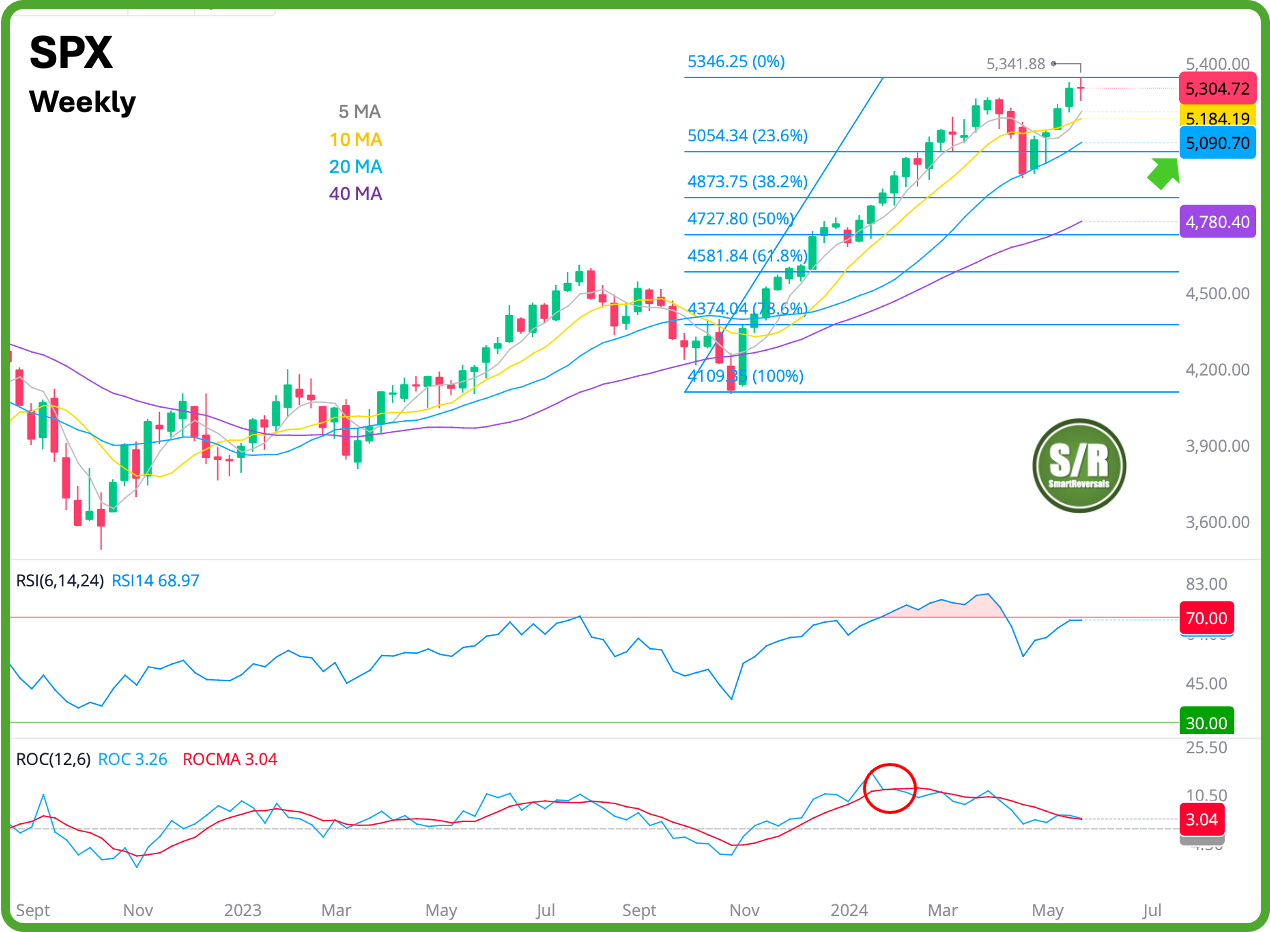SPX Stalls at Fibonacci Hurdle: Bullish Cross on Hold?
Two pullbacks were quickly bought during the week. Price action has been choppy, NDX and SPX closed the week at annual Resistance Levels. Did NVDA save the week? Is that sustainable?
“The Compass at the Top”
Two weeks ago Small Caps closed with a candle that suggested a top, then the week after GME came to the rescue and the red weekly candle came up for IWM until this week. Is NVDA the same case for SPX and NDX?
DXY, TNX and VIX bounced triggering a bearish daily engulfing candle on Thursday for the indexes but Friday closed again green with a daily inside candle that in the past has been a normal technical bounce before resuming the downtrend.
There are cracks in the ship and two annual resistance levels for SPX and NDX may bring the turbulence that was seen for DJI this week, which by the way is the most diversified index and it does not include NVDA.
SPX's attempt at a MACD bullish crossover last week was delayed. The latest weekly candle reflects indecision, but considering the Fibonacci 161.8% extension level (based on the bear market bottom and July 2023 high), the current position is noteworthy.
Price action at any support or resistance zone requires evaluation. The current level suggests caution. If the Fibonacci level is crossed, it might lose its resistance power. $5305 sits within this Fibonacci zone, aligning with the weekly candle's body.
An open on Monday above 5301 would maintain the bullish context, and $5345 would be the next level to watch.
Since NDX closed in a confluence zone for two resistance levels, and Dow Jones presented a very weak Friday, the bearish thesis is still on, and a potential healthy pullback has to be considered.
I don’t expect a big correction coming, the level where I will start to be in extreme caution was shared last week.
Potential Pullback and Support Revised:
Since there is a bearish divergence with ROC and another with RSI, it’s very important to measure risk, remember the special studies about overextensions that I have posted, trading is about consistency and the learnings have to be applied.
Support levels have risen: The 40-week moving average is currently at $4780 and trending upwards, while the 10-month moving average sits at $4786. A visit to these levels does not happen in a week, suggesting $4850 might be a worst-case scenario based on the 40 week-average, since that was the bottom of pullbacks during overextensions.
Consistency on Support: My previous statement about $5110 serving as support for the rest of the year remains unchanged, the following analysis of Fibonacci Retrace presents a relevant support at $5054, very close tho the annual S/R level $5110. The confluence of those levels provide strong support, and if there is a green Tuesday or 5345 is reached before a pullback, that Fib will raise nearing $5110.
The educational content about Fibonacci Retrace can help if there is a question:
Technicals and Preparation: Trading involves finding the best technical explanation for price action. Being prepared for deviations is key. The market rarely surprises technically; the mistake lies in clinging to any single indicator, hence the update about Fibs.
Other Elements for Analysis:
VIX (Volatility Index):
I pay close attention to VIX. This week's chart shows more volatility compared to previous ones (Not a straight red candle this time but an attempt to bounce and potential reversal considering formation + oscillator). While I mentioned a potential VIX breakout last week using the daily chart, the weekly chart alone today suggests a defensive stance for U.S. Indexes. Once again, 12.95 is the resistance level that once broken will bring turbulence to the market. Yellow arrows show similar candles in recent months and a spike came one or two weeks after.
DXY (US Dollar Index):
The DXY bounced as the 40-week moving average suggested last week, but it fell again on Friday, forming a bearish continuation candlestick pattern. The 40MA is back on stage, so a breakdown point at $104.4 is possible, which is the nearby average. A MACD cross would seal the deal for that move. Bullish for indexes below $104.4, bearish if DXY bounces.
TNX (Treasury Yield):
For bullish continuation in TNX (which would be negative for stock indexes), it needs to rise above 4.5%. Conversely, if it keeps dropping, the key support level to watch for a potential bounce is 4.3%. The 40-week moving average, which has acted as support since late 2021, is still trending upwards. Unless 4.3 breaks, 4.82 might be a target before a significant pullback. Bearish for indexes above 4.5%, bullish for indexes below 4.3%.
TLT (Long-Term Treasury Bond):
TLT is struggling with the 20 weekly average. While the recent candle wicks aren't entirely bearish, they don't indicate strong bullish conviction either. On the daily chart, a recovery above 91.57 is needed to consider bullish continuation. Currently, the gap fill at 90.92 in the daily is positive for bulls. The biggest hurdle for a potential bull run would be at 92.1, where the 20-day moving average currently sits.
NDX (Nasdaq 100)
Neared $18964, an annual resistance that rejected price on Thursday at the open and there is also a flat Bollinger Band nearby which makes it a harder resistance. The candle is bullish and there is a potential bullish MACD crossover that doesn’t look interrupted as the one for SPX (not in chart since my main concern are the resistance lines). There are good chances of a bullish opening next week, so price action has to be monitored carefully between 18862 and 18964, which is a hot zone where bearish reversals could happen given the confluence of two resistance levels.
Bullish above $18755, and $18960 is also a weekly S/R level, so there are three levels in confluence that may reject price, or saying it in another way: A very strong injection of good news would be needed to cross $18960 with comfort.
DJI (Dow Jones)
The big index without NVDA in its stocks list declined this week as the daily shooting star warned last week (the daily chart zoomed is the same from last week).
This is a very relevant benchmark for NDX for several reasons: The higher Bollinger Band matched the annual $39,835 S/R level (equivalent to NDX’s $18,964), in addition the bullish MACD crossover was delayed.
The latest candle for DJI closed at 10 and 5 MA, there is low weekly volume validating the bearish candle but the best case scenario for DJI is a doji type candle.
BREADTH:
When a mega-cap like NVDA jumps more than 10% in the week and MSFT 2.32%, there is a significant influence to keep up the indexes, something similar to the previous week when GME exploded and IWM moved up despite a bearish setup. This week IWM finally fell, we’ll learn if the resistance levels mentioned for NDX reject price.
That said, there is breadth deterioration, as expected last week, but remember: Breadth has to be analyzed as one of many factors, like an oscillator or a divergence, instead of a trigger to buy or sell a stock.









